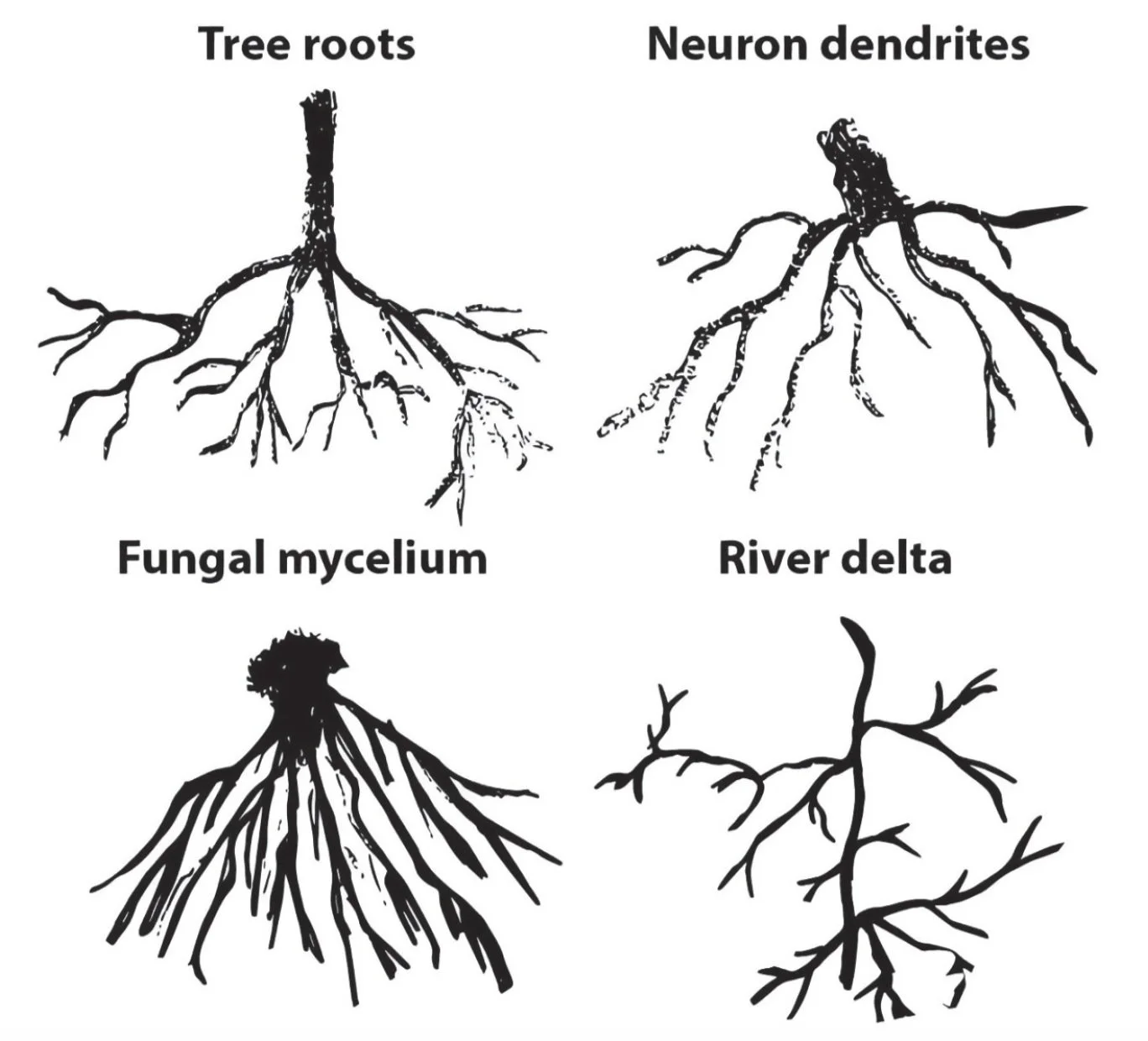The branching principle: Why so much of life forks and fans
While writing Treewilding, I became fascinated by how so much of life ‘forks and fans’. My curiosity was recently reignited by pondering how and why fungi respond to acoustic waves and other vibrations.
Just a few days ago, I was deep in the details of a scientific paper when I paused, closed my eyes and let my mind wander. I began thinking about roots and mycelial networks, but then river deltas, lightning bolts and lungs crept in – as did a peculiar sense of awe. The same branching pattern appears again and again.
A tree limbs into boughs and twigs, while deep in the squishy caverns of our brain, neurons arborise into similar tangled networks. Fungal mycelia radiate filaments through soils, blood vessels bifurcate, and river systems similarly fracture into distributaries. Even lightning forges a jagged path through the air, while corals and bronchioles in your lungs share this same recursive form.
This isn’t a coincidence. It’s a convergent solution to a universal problem. And the problem? How to move things—information, nutrients, energy, gases—through space, efficiently and adaptively.
Branches - from Treewilding
Branching structures evolve because they optimise exchange. In trees, vascular tissue fans out to distribute water and sugars across expanding leaves. In the lungs, bronchioles increase surface area to maximise gas exchange across alveoli. In the brain, dendritic branching enables more synaptic inputs. Fungal mycelia expand like living maps of efficiency, probing and colonising patchy substrates. Rivers branch where topography and sediment dynamics demand distributed flow. Lightning propagates along paths of highest electrical conductivity, often branching in response to fluctuations in local electric fields and atmospheric conditions.
Some of these systems are described as fractal-like. In other words, they display self-similar patterns at different scales. And while not all biological branching is truly fractal in the strict mathematical sense, they do exhibit scale efficiency. They reduce energy loss, shorten transport times and enable robust responses to changing conditions.
So why does this matter?
Perhaps the most elegant answer to this is “because form reflects function”. Sure, the aesthetics of branching and fractal patterns are pleasing to humans. Indeed, simply looking at such patterns may have a biochemical influence on your body and mind, making you feel calmer. But aesthetics aside, it’s an emergent ‘design’ solution, honed by evolution, physics and feedback. It offers clues about how life scales, senses and adapts. And beyond biology, it becomes a metaphor for complexity itself. Evolutionary lineages branch. Language trees branch. Scientific disciplines branch. The shape of knowledge—and our nervous systems—are recursive and distributed.
In my own research, looking at microbial ecologies and biodiversity-health linkages, I often reflect on how life builds meaning through connection. Mycelia, for instance, don’t grow randomly. They branch towards signal-rich environments. Neurons strengthen connections through activity. Both are selective. Both learn.
What’s profound is that branching enables resilience without central control. There’s no single leader in a tree, a river delta or a fungal network. Instead, the system adapts through decentralised feedback and local sensing, allowing flexible responses to changing conditions. Perhaps that’s why branching evokes such curiosity (in me, at least)! Like us, the rest of nature stays ‘curious’, reaching, testing, growing.
And maybe there’s something we can learn from that. As our own societies and relationships with ecosystems become more complex, the linear, top-down models start to crack. The future might belong to branching systems: modular, flexible, regenerative.
The branching principle could simply be viewed as how life spreads… But it’s also how it thrives.
Read more in Treewilding: Our Past, Present and Future Relationship with Forests
Check my other blog posts: www.jakemrobinson.com/blog

